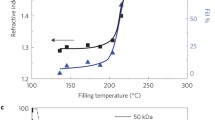Abstract
The yield response of nine architecturally different glassy networks is investigated under several stress states, strain rates, and temperatures, and correlations are made among them. Differences in molecular architecture are quantified through two proposed governing parameters; the glass transition temperature, T g, capturing network stiffness and the cohesive energy density, E c, reflecting network strength. Cohesive energy density is estimated using molecular modeling techniques and supported by solvent swelling experiments. The limits of the correlations made between molecular architecture and yield behavior are further studied with attempts to relate yielding in thermoplastic glasses and heterogeneous networks.








Similar content being viewed by others
References
www.freedoniagroup.com/Epoxy-Resins-In-North-America.html
Sternstein SS, Ongchin L (1969) ACS Polym Prep 10:1117
Sultan JN, McGarry FJ (1973) Polym Eng Sci 13:29
Carapellucci LM, Yee AF (1986) Polym Eng Sci 26:920
Kinloch AJ, Young RJ (1983) Fracture behavior of polymers. Applied Science Publishers, London, pp 116–117, 172
Robertson RE (1966) J Chem Phys 44:3950
Duckett RA, Rabinowitz S, Ward IM (1970) J Mater Sci 9:909
Sha Y, Hui CY, Ruina A, Kramer EJ (1995) Macromolecules 28:2450
Baljon ARC, Robbins MO (2001) Macromolecules 34:4200
Chui C, Boyce MC (1999) Macromolecules 32:3795
Yang L, Srolovitz DJ, Yee AF (1997) J Chem Phys 107:4396
Rottler J, Robbins MO (2001) Phys Rev E 64:051801
Theodorou DN, Suter UW (1986) Macromolecules 19:139
Hertzberg R (1989) Deformation and fracture mechanics of engineering materials, 3rd edn. John Wiley and Sons, New York
Crawford E, Lesser AJ (1998) J Polym Sci Part B: Pol Phys 36:1371
Crawford E, Lesser AJ (1997) J Appl Polym Sci 66:387
Graessley WW (1975) Macromolecules 8:186
Flory PJ (1979) Polymer 20:1317
Lesser AJ, Calzia KJ (2004) J Polym Sci Part B: Pol Phys 42:2050
Calzia KJ, Lesser AJ (2004) Abstr Pap Am Chem Soc 227:471-PMSE Part 2
Calzia KJ, Lesser AJ (2004) SPE ANTEC Tech Papers, 50
van Krevelen DW (1976) Properties of polymers, 2nd edn. Elsevier, Amsterdam, pp 129–159
Allen MP, Tildesley DJ (1987) Computer simulations of liquids. Oxford University Press, Oxford
Kody RS, Lesser AJ (1997) J Mater Sci 32:5637
Donnellan TM (1992) J Polym Eng Sci 32:415
MacKinnon AJ (1995) J Polym Sci Part B: Pol Phys 58:2345
Cook WD (1999) Polymer 40:1209
Sindt O, Perez, J (1996) Polymer 37:2989
Chaplin RP (1994) Polymer 35:752
Ober CK, Kramer EJ (1998) Macromolecules, 31:40
Acknowledgements
The authors wish to thank the Center for UMass/Industrial Research in Polymers (CUMIRP) Cluster M that receives support from Essilor, International Paper, Loctite, and Meadwestvaco. In addition, they thank the Army Research Labs and the National Science Foundation for their support of the Materials Research Science and Engineering Center (MRSEC). They also would like to acknowledge Dow Chemical for the plane strain test results and funding.
Author information
Authors and Affiliations
Rights and permissions
About this article
Cite this article
Calzia, K.J., Lesser, A.J. Correlating yield response with molecular architecture in polymer glasses. J Mater Sci 42, 5229–5238 (2007). https://doi.org/10.1007/s10853-006-1268-0
Received:
Accepted:
Published:
Issue Date:
DOI: https://doi.org/10.1007/s10853-006-1268-0




